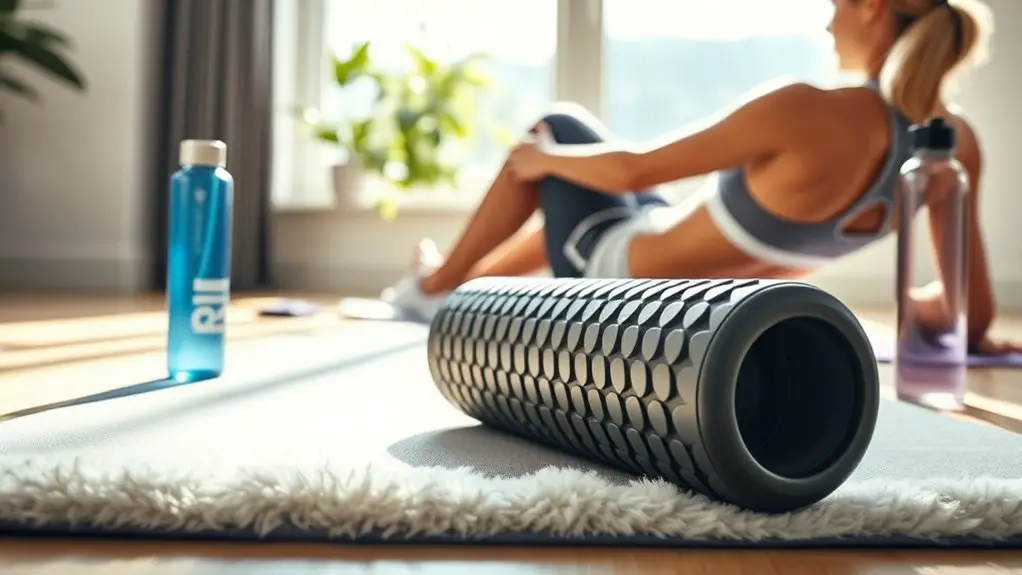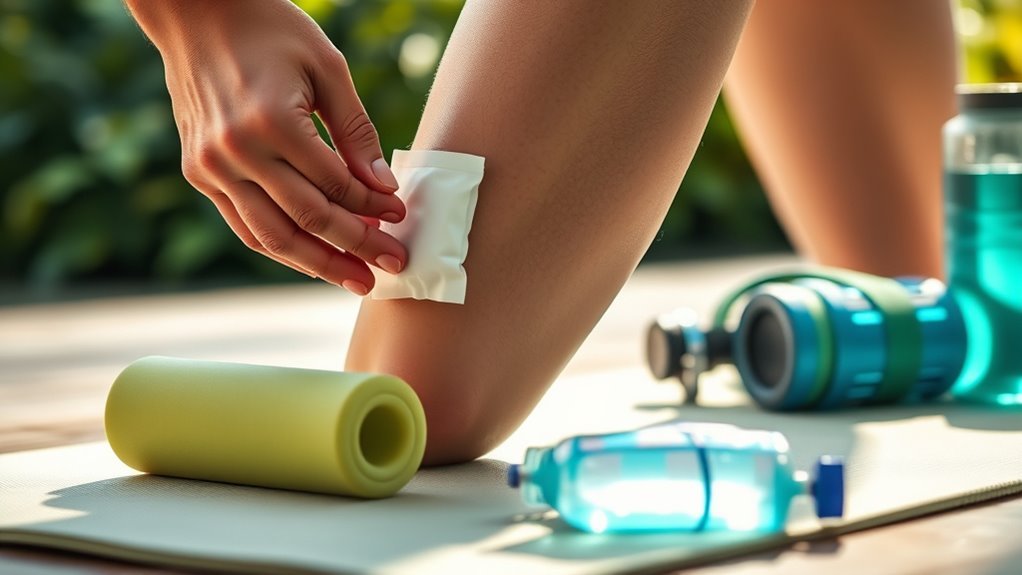To properly use foam rollers for recovery, start by choosing the right roller based on density, size, and texture. Position it under the muscle group you want to target. Apply your body weight and roll slowly, pausing on tight spots for 20-30 seconds while breathing deeply. Focus on areas like your upper back, quads, and hamstrings. Consider timing your sessions before or after workouts to maximize benefits. There's plenty more to discover about how to make foam rolling work for you!
Understanding the Benefits of Foam Rolling
Although foam rolling might seem like just another fitness trend, it offers numerous benefits that can enhance your recovery process. You'll find that foam rolling helps alleviate muscle soreness and tightness, allowing you to move freely and comfortably. It increases blood flow, which promotes healing in your muscles, letting you bounce back faster after intense workouts. By breaking up fascia and reducing tension, foam rolling can improve your range of motion, enhancing your overall performance. Plus, it's an easy way to incorporate self-care into your routine; just a few minutes can make a big difference. So, if you're looking to feel liberated in your movements and recover efficiently, foam rolling is a powerful tool to add to your wellness arsenal.
Choosing the Right Foam Roller
When it comes to choosing the right foam roller, it's important to take into account your specific needs and preferences. With so many options out there, you'll want to find one that fits your lifestyle and recovery goals. Here are three key factors to weigh:
- Density: Softer rollers provide a gentler touch, while firmer ones target deeper muscle layers, perfect for those who crave intensity.
- Size: Longer rollers offer stability for larger muscle groups, while smaller ones are great for portability and focusing on specific areas.
- Texture: Smooth rollers give an even pressure, while textured surfaces can enhance muscle release, giving you that satisfying relief.
Key Techniques for Effective Foam Rolling
To maximize the benefits of foam rolling, it's essential to employ effective techniques that target your specific muscle groups. Start by positioning the foam roller under the area you want to work on, using your body weight to apply pressure. Roll slowly, pausing on tight spots for about 20-30 seconds. Remember to breathe deeply and relax your muscles.
Here's a simple table to visualize your foam rolling routine:
| Technique | Duration | Frequency |
|---|---|---|
| Slow Rolling | 1-2 mins | 2-3 times |
| Targeted Pressure | 20-30 secs | As needed |
| Dynamic Movement | 1 min | After rolling |
These techniques can help you reveal your body's potential, promoting recovery and freedom in movement. Enjoy the journey!
Target Areas for Muscle Release
Foam rolling can be particularly effective when you focus on specific target areas that often hold tension. By zeroing in on these muscle groups, you'll free up tightness and enhance your recovery. Here are three key areas to target:
Focus on key muscle groups to release tension and boost recovery through effective foam rolling techniques.
- Upper Back: Roll across your shoulder blades to release tightness from long hours of sitting or intense workouts.
- Quads: Glide along the front of your thighs to alleviate soreness, especially after leg day or long runs.
- Hamstrings: Target the back of your thighs to relieve stiffness from both sitting and high-intensity activities.
Timing Your Foam Rolling Session
Finding the right time for your foam rolling session can greatly enhance its benefits. You can choose to roll before or after workouts, depending on your goals. Foam rolling before a workout preps your muscles, while rolling afterward helps with recovery.
Here's a quick guide to help you decide:
| Timing | Purpose |
|---|---|
| Before Workout | Increases blood flow |
| After Workout | Reduces muscle soreness |
| On Rest Days | Maintains flexibility |
Listen to your body and experiment with different times. Whether you start your day or wind down at night, foam rolling can be a liberating routine that keeps you feeling great and ready for whatever comes next!
Incorporating Foam Rolling Into Your Routine
Incorporating foam rolling into your routine can transform your recovery process and overall performance. It's all about making it a habit that fits your lifestyle. Here's how to seamlessly add foam rolling to your day:
- Pre-Workout Roll: Spend a few minutes loosening tight muscles before you hit the gym. Feel the tension melt away, giving you freedom of movement.
- Post-Workout Ritual: Use the roller after your workout to enhance recovery. Let the foam soothe your muscles, promoting relaxation and reducing soreness.
- Daily Reset: Roll for 10 minutes daily, even on rest days. It's a chance to reconnect with your body, keeping you agile and ready for life's adventures.
Embrace foam rolling, and watch your body thank you!
Common Mistakes to Avoid
What pitfalls should you steer clear of when using a foam roller? First, don't rush through your rolling. Take your time and let the muscle relax; otherwise, you won't get the full benefits. Also, avoid rolling directly over joints or bones; stick to the muscle tissue to prevent injury. It's essential not to apply too much pressure, especially if you're new to this practice. You might think more pressure equals better results, but that can lead to soreness or damage. Finally, don't forget to breathe! Holding your breath can increase tension and negate the relaxation you're aiming for. By steering clear of these common mistakes, you'll enjoy a more effective and liberating recovery experience.
Frequently Asked Questions
Can Foam Rolling Help With Injury Prevention?
Absolutely, foam rolling can help with injury prevention. It improves flexibility and circulation, reduces muscle tightness, and enhances recovery. Incorporating it into your routine can keep you moving freely and reduce the risk of injuries.
How Often Should I Foam Roll Each Week?
You should foam roll two to three times a week for ideal results. Listen to your body; if you feel tightness or soreness, don't hesitate to roll more frequently. Balance is key for recovery.
Is Foam Rolling Safe for Everyone?
While foam rolling's generally safe for most, it's wise to tread lightly if you have specific conditions or injuries. Always listen to your body, and don't hesitate to consult a professional for guidance.
Can I Use a Foam Roller During My Workout?
Yes, you can definitely use a foam roller during your workout! It helps to warm up muscles, improve flexibility, and enhance your performance. Just listen to your body and roll where it feels good. Enjoy!
What Should I Do if It Hurts Too Much?
If it hurts too much, don't push through the pain. You might want to ease up on the pressure, switch to a softer roller, or take a break until you're more comfortable. Listen to your body!




